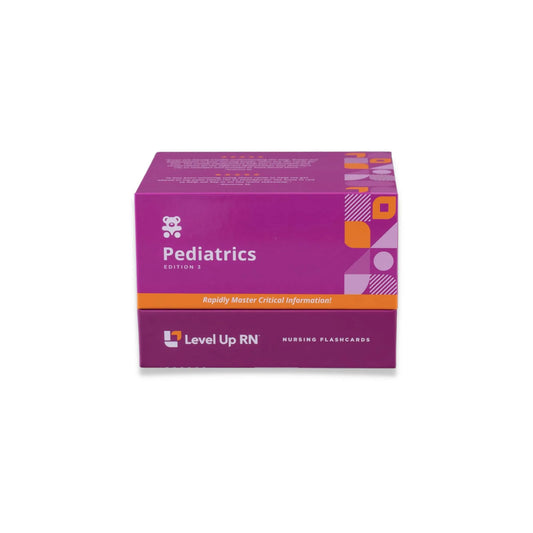Peds, part 22: Cardiovascular Disorders - Catheterization, Congenital Heart Defects
A cardiac catheterization, including nursing care of the patient before and after the procedure. Congenital Heart Defects (CHDs). The pathophysiology, risk factors, overall signs/symptoms, diagnosis, treatment, and nursing care of patients with congenital heart defects.
Full Transcript: Peds, part 22: Cardiovascular Disorders - Catheterization, Congenital Heart Defects
Full Transcript: Peds, part 22: Cardiovascular Disorders - Catheterization, Congenital Heart Defects
Hi, I'm Cathy with Level Up RN. In this video, I'm going to begin my coverage of pediatric cardiovascular disorders. Specifically in this video, I will be talking about a cardiac catheterization and congenital heart defects. If you have our Level Up RN pediatric nursing flash cards, definitely pull those out so you can follow along with me. And at the end of the video, I'm going to give you guys a little quiz to test your knowledge of some of the key points I'll be covering in this video, so definitely stay tuned for that. A cardiac catheterization is an invasive procedure that can be used to diagnose a congenital heart defect, as well as repair certain congenital heart defects. So during this procedure, a catheter is inserted into the femoral artery and then threaded up to the heart. So in terms of nursing care, prior to the procedure, you want to make sure your patient has been NPO for six to eight hours. You also want to assess for any allergies to iodine or shellfish. Because if a patient has an allergy to iodine or shellfish, this increases the risk of an allergic reaction to the contrast dye used in the procedure. We also want to assess our patient's kidney function because contrast dye is very hard on the kidneys. So we want to take a look at our patient's creatinine and BUN levels, and then we want to assess and mark our patient's distal pulses. And we do this so that we can easily find those pulses after the procedure and compare them to what we felt before the procedure.
So after your patient has had their cardiac catheterization, you want to check the insertion site for bleeding, and then you want to check the extremity distal from the insertion site to ensure we have good blood flow. So we want to check those pedal pulses. We want to check the patient's capillary refill, their color, and their temperature, and then we need to increase our patient fluid intake to help flush out that contrast dye. And we need to position our patient in a supine position with the affected extremity straight for four to six hours or per facility policy after the procedure. Next, let's talk about congenital heart defects. In this video, I'm going to talk more broadly about congenital heart defects, and then starting in my next video, we will get into specific congenital heart defects. So a CHD or congenital heart defect is an anatomic abnormality of the heart that causes altered blood flow. So with this condition, the fetal heart has not developed properly due to genetic and/or environmental factors. So risk factors associated with an increased risk of a congenital heart defect include exposure to a teratogenic during pregnancy, as well as maternal smoking and alcohol use and maternal medical conditions such as diabetes.
Congenital heart defects are categorized based on the type of altered blood flow that they cause. So certain defects caused increased pulmonary blood flow, others cause decreased pulmonary blood flow, others cause an obstruction of blood flow, and then finally, we have some that cause mixed blood flow. Signs and symptoms of a congenital heart defect will depend on the specific defect present. However, many of these defects will cause heart failure, hypoxemia, and murmurs. So I will have a separate video that goes into detail about heart failure. But heart failure can result in dyspnea, so difficulty breathing, edema, activity intolerance, poor feeding, fatigue, as well as cardiomegaly, so enlargement of the heart. With hypoxemia, we have insufficient oxygenation of the blood. That can result in hypoxia, which is where we have insufficient oxygenation of the body's tissues. In terms of diagnosis of a congenital heart defect, we can use diagnostic tools such as an EKG, echocardiogram, cardiac catheterization, as well as an MRI or a chest X-ray. Treatment options include surgical repair, repair with a cardiac catheterization. Medications can be used for certain defects and also to treat heart failure. And then a heart transplant may be required. In terms of nursing care, we're going to want to provide frequent rest periods for our child and also provide small, frequent meals. We should provide oxygen as ordered as well as high-calorie formula as ordered by the provider.
All right. It's quiz time. I have three questions for you. First question, your patient should be assessed for what specific allergies prior to a cardiac catheterization? The answer is an allergy to iodine and shellfish. Question number two, how should the patient be positioned following a cardiac catheterization? The answer is, they should be positioned in a supine position with the affected extremity straight. Question number three, a congenital heart defect can cause which of the following: hypoxemia, heart failure, murmurs. The answer is all of the above, and that was kind of an easy question. But enjoy it because, with my next video, the questions are going to get a little harder. Okay. I hope this video has been helpful. Definitely stay tuned for my next video where I get into specific congenital heart defects. Take care, and thanks so much for watching.



1 comment
Watching these videos are super helpful! I highly recommend watching these to help throughout nursing school!!